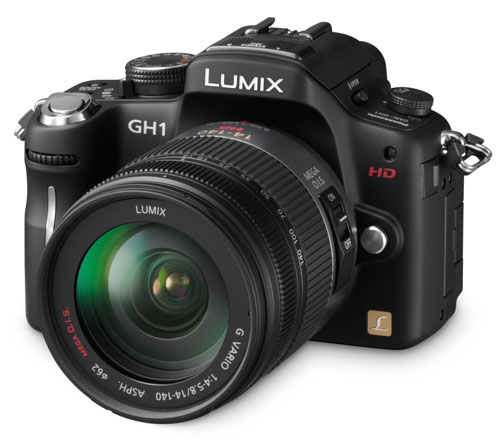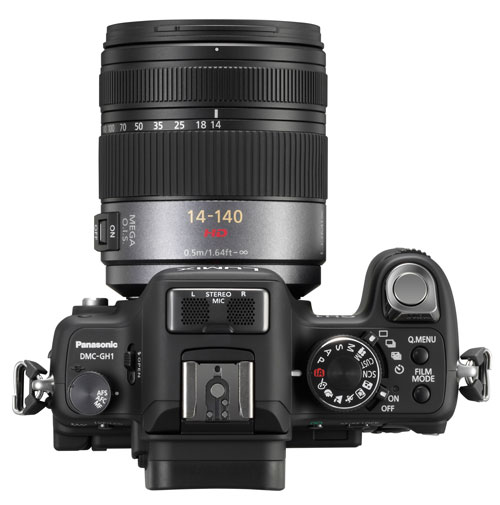PMA 2009: Panasonic GH1 & Olympus E620
by Wesley Fink on March 9, 2009 5:40 PM EST- Posted in
- Digital Camera
Panasonic GH1
When the Panasonic G1 was first announced it created a great deal of excitement for its potential to reduce interchangeable lens digital camera size by eliminating the mirror box of the Digital SLR. The actual G1 was indeed small, but not as small as many hoped. The performance and feature set, however, were outstanding, as we discussed in some detail in Digital Cameras for the Holidays. There was also the clear promise that future Micro 4/3 cameras could be even smaller and even more pocketable.
One of the most intriguing possibilities for Micro 4/3 was the promise of future video recording capabilities. Panasonic was clear that the new standard was definitely designed with video in mind and that it would be coming in the near future.
The tiny interchangeable lens Micro 4/3 cameras did not arrive at PMA 2009. Exhibitors said they were coming but it was just too soon. However, the HD video version of the G1 was announced with most of the bells and whistles promised by Panansonic.

It is true that Nikon introduced video on the D90, but it was lacking any auto-focusing capabilities at all. Canon improved the video to full HD on the $2700 5D Mark II, with incredible image quality results. However, the 5D Mark II is still limited to a contrast-detect AF system that is so slow that it can severly limit video recording capabilities.
The Panasonic GH1 featured only contrast-detect focusing, which had been dramatically improved to be as fast as competitor DSLRs traditional phase-detect AF. With that in mind it should come as no surprise that the Panasonic GH1 actually delivers very usable HD video recording with fast AF and real-time fact detection. In fact the best HD video of the interchangeable lens digital still cameras, and the first to actually deliver a video recording system on a “DSLR” without severe limitations.
The Panasonic Lumix DMC-GH1 is even bundled with a kit lens designed for video, with a super silent AF motor and continuous AF. The LUMIX G VARIO HD 14-140mm/F4.0-5.8 ASPH./MEGA O.I.S comes with the camera or it is also available as a separate purchase).

Body design is nearly unchanged from the G1 model. The changes include a stereo microphone housed on the top of the popup flash and a new movie record button on the rear panel that can be easility operated with the thumb to start and stop video recording. The rest of the exterior changes are just cosmetic, like the red "HD" under the AF assist light on the front panel. The G1 came in black, rd, and blue, while the GH1 will be available in black, red and gold body colors.
The high-definition video capabilities of the GH1 continuous autofocusing capability with the new 12.1 Live MOS sensor while videos are being recorded. Movies can be recorded at 1080i (1920 x 1080) or 720p (1280 x 720 pixels. 1080i videos are actually captured at 24 fps with progressive-scan (25fps PAL), and then converted and written in the camera as 60fps interlaced (50fps PAL). 720p is captured and written as 60 fls progressive scan (50fps PAL).
the GH1 can also offer an impressive 60 frames-per-second (NTSC; 50 frames per second for PAL). Note though that 1080i videos are actually captured at 24 fps progressive-scan (NTSC; 25fps PAL), and then converted in-camera to be written as 60fps interlaced (NTSC; 50fps PAL).
With the LUMIX G VARIO HD 14-140mm/F4.0-5.8 MEGA OIS lens keeps AF noise very low to not interfere with audio recording. In addition the GH1 can use Face Detection Intelligent Exposure, Optical Image Stabilization, and even an Intelligent Scene Selection all while recording videos.
The Panasonic GH1 specifies the same 12.1 megapixel resolution as the G1, but Panasonic says the GH1 sensor is a new design. The sensor is actually 14 megaixels in a 4/3 size (2:1 lens ratio) that allows 12.1 Megapixels in a number of aspect ratios like 4:3, 3:2, or 16:9. The extra pixels allow the same angle of view over the range of ratios available in the GH1.
The availability and price of the GH1 were not announced at PMA, but details should be announced very soon. If you have been looking for a truly capable video camera with interchangeable lenses you should check out the new GH1 when it finally ships. As a bonus it will capture 12.1 Megapixel still images over a wide ISO range.










12 Comments
View All Comments
Flyboy27 - Tuesday, March 10, 2009 - link
Are there any lenses for micro 4/3 cameras besides the kit lenses. I can't find anything. All I see are regular 4/3 lenses. Are they compatible?Wesley Fink - Thursday, March 12, 2009 - link
Panasonic also announced the LUMIX G VARIO 7-14mm/F4.0 ASPH lens introduction at PMA 2009. That brings the micro four-thirds lenses to four so far. The 7-14mm is equivalent to a 14-28mm lens on a 35mm.Wesley Fink - Tuesday, March 10, 2009 - link
You might want to refer back to the Panasonic G1 launch article at http://www.anandtech.com/digitalcameras/showdoc.as...">http://www.anandtech.com/digitalcameras/showdoc.as... where we discuss the technology, accessories, and roadmap in more detail.Wesley Fink - Tuesday, March 10, 2009 - link
There are currently 3 Micro four-thirds lenses and all three have optical imaging stabilization with Mega O.I.S. In addition to the 14-140mm HD kit lens for the GH1, there is the $349 MSRP 45-200mm OIS and the G1 kit lens 14-45 OIS. Many more Micro 4/3 lenses are planned.Four-thirds lenses from Olympus, Leica, Panasonic and Sigma will work on the micro four-thirds mount with an adapter. Some fully support contrast detect AF and some do not. You can see a complete list of 4/3 lenses at Olympus. The Panasonic DMW-MA1 micro 4/3 adapter is available for around $169 at Amazon and other vendors. I have seen it advertised as low as $104.
One of the lenses that works perfectly with the adapter on micro 4/3 is the Leica 25mm f/1.4. I also have used the micro 4/3 mount 45-200mm, which is equivalent to a 90-400mm 35mm lens and it is very good quality with useful image stabilization.
A new adapter for micro 4/3 was just introduced for Leica M lenses. There are also adapters that will allow you to mount many other lenses like Canon, Nikon, Pentax, etc. on the micro 4/3 but they will be manual focus on the G1 and GH1.
extra - Friday, March 13, 2009 - link
"Some fully support contrast detect AF and some do not."Yeah, most of them don't. However, the good news is this: Panasonic is on the ball here. With how on top of things they have been with their camera line up, they are clearly very focused on their imaging division at the corporate level.
What this means is that you can pretty much count on there being a full lineup of great lenses from them. It's not going away. I wouldn't worry about the lenses that may be available in the future as long as you can live with what they've got now. Also, their lenses are optically quite good, even the kit ones~!
SuperflyDK - Tuesday, March 10, 2009 - link
Quote: "However, in a very un-entry move, the 5 center AF points are all double-cross – sensitive to both horizontal and vertical. The entry competition has at best one center cross-point..."The Canon competition has this as well, so now there are 2 manufactures with 7 (or Canon 9) crosssensitive autofocus points in the upper prosumersegment.
Both the Canon EOS 40D and the 50D has a 9 point crosssensitive AF.
Cool regards,
Superfly
Wesley Fink - Tuesday, March 10, 2009 - link
The E-620 is entry, not upper prosumer, and nothing from Canon or Nikon in the entry area (XSi, XS, D60) has multiple AF cross-points that I am aware of. The XSi/XS has 9/7 AF points with only the center as double-cross. The D60 has 3 points and I don't think any of them are cross-point though the center one may be.The E-620 competes at entry and it is not really fair to compare it to mid-range Canon's like the 40D/50D. The Olympus E-30 competes in that market, and it has 11 AF cross-points in two planes (44 total AF points).
extra - Friday, March 13, 2009 - link
Correct. *HOWEVER* there is a lot more to auto focus than simply being able to detect contrast in multiple directions. Having those multiple cross-type sensors doesn't automatically mean that the af on this thing is going to be better than canon or nikon af. Also remember that 4/3 is a much smaller sensor than aps-c. So I wouldn't get too excited about this thing yet, reserve judgment until more people have gotten to play with it.teldar - Sunday, March 15, 2009 - link
I believe he was replying to the inaccurate statement made by a previous poster. And since HE would be the person reviewing the camera for DT (he he is able to get a review sample) he would probably be the one who is most knowledgable and reliable about its performance if/when it's reviewed.finbarqs - Tuesday, March 10, 2009 - link
From panasonic's anouncement, they said that the camera will deliver full 1920x1080p video @ 24fps with full exposure controls